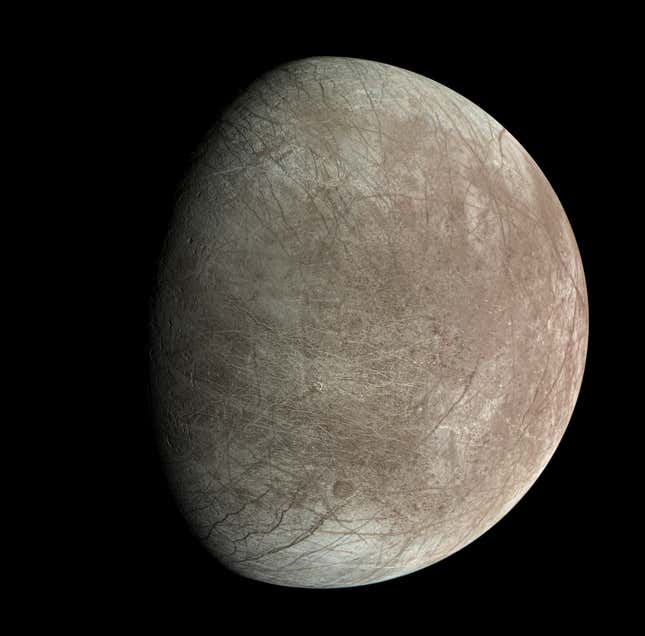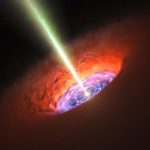Key Takeaways:
- Juno captured incredibly detailed images of Europa’s icy surface, suggesting the crust has moved and hinting at possible recent activity.
- The surface features support the idea that Europa’s icy shell is independent of its core and may have shifted at the poles.
- A strange, reddish-brown region nicknamed “Platypus” was observed, potentially linked to subsurface water.
- Surface features suggest Europa’s icy crust is likely less than 90 million years old.
- This upcoming mission (2030) will further investigate the possibility of a subsurface ocean and potential for life.
NASA’s Juno spacecraft flew by Europa on September 29, 2022, getting as close as 220 miles (355 kilometers) to the frozen surface of the Jovian moon. Incredible details of the chaotic terrain of Europa were revealed in close-up, suggesting that the icy crust of the moon has moved. The images also showed a newly discovered feature that was nicknamed “Platypus” for its odd shape.
The results obtained from the high-resolution images taken by the spacecraft’s Stellar Reference Unit (SRU) were published in the journal JGR Planets, while the findings made possible by the JunoCam images were recently published in the Planetary Science Journal.
NASA estimates that beneath the icy surface of Europa is a salty ocean with twice the volume of all the oceans on Earth. The lunar surface exhibits a complex system of ridges and dark stains, which could be a sign of water vapor plumes venting into space.

During the close flyby, Juno’s SRU took this black-and-white image of Europa’s surface. It shows a region that is crisscrossed with a network of fine grooves and double ridges, or pairs of long parallel lines, which indicate elevated features in the ice. The intense radiation surrounding the moon causes the small white dots that are visible throughout the image to be high-energy, penetrating particles. In the meantime, the dark stains might be related to cryovolcanic plume activity, which is the bubbling up of liquid from beneath the ice.
The Platypus, with its widest point measuring 42 miles (67 kilometers) is located at the bottom right of the picture. It has noticeable ridges and is composed of a dark reddish-brown material. The substance is lumpy and contains blocks of ice that range in height from 0.6 to 4.3 miles (1 to 7 kilometers).
Ridge formations around the edges of Platypus collapse into the popular feature. These formations lend support to the idea that areas of the moon where pockets of briny water from the subsurface ocean may exist beneath the surface could eventually give way from the icy shell. Heidi Becker, lead co-investigator for SRU at NASA’s Jet Propulsion Laboratory, said in a statement that “these features hint at present-day surface activity and the presence of subsurface liquid water on Europa.”

The detailed features of the fractures, ridges, and bands that crisscross the moon’s surface are visible in the photos taken by the JunoCam visible light camera on board the spacecraft. NASA claims that these features on Europa’s surface have eliminated land that is older than roughly 90 million years.
The idea that Europa’s outer ice shell is essentially free-floating is supported by these surface features. The icy crust at Europa’s north and south poles is said to have moved, according to the “true polar wander” theory.
“True polar wander occurs if Europa’s icy shell is decoupled from its rocky interior, resulting in high stress levels on the shell, which lead to predictable fracture patterns,” Candy Hansen, a Juno co-investigator who leads planning for JunoCam at the Planetary Science Institute in Tucson, Arizona, said in a statement. The fact that these fracture patterns have never been tracked in the southern hemisphere implies that true polar wander has a wider impact on Europa’s surface geology than previously thought.
The JunoCam images prompted a reassessment of a notable feature on Europa’s surface. Initially believed to be an impact crater measuring 13 miles (21 km) in width, Hansen observed that Gwern was actually an oval shadow formed by the intersection of ridges.
NASA launched the Juno mission in 2011 with the goal of studying Jupiter and its moons. Scientists are particularly interested in Europa because they want to know if life could have developed on the icy moon. More spacecraft are being sent to the moon in order to investigate its peculiar features. In order to determine whether an ocean truly exists beneath Europa’s icy crust, NASA’s Europa Clipper mission is scheduled to arrive at Jupiter in 2030 and conduct magnetic field research. In order to study the gas giant and its three moons that contain oceans, the European Space Agency’s JUICE mission is currently traveling to the Jovian system.


